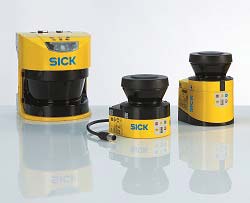
Posted to News on 23rd Jul 2012, 17:29
Safety laser scanners boost AGV productivity and safety
Seb Strutt, a Senior Product Manager at Sick UK, explains how safety laser scanners provide not only collision protection for automated guided vehicles, but they can also enable the speed and production throughput of vehicles to be increased, and downtime and maintenance requirements to be cut.

Recent technological advances, which have made safety laser scanners even more compact, have delivered major advances in the use of Automated Guided Vehicles (AGVs).
Before the advent of laser techniques, contact bumpers were used. The approach speed of the driverless AGV therefore had to be limited to ensure that the impact force did not cause harm.
The introduction of the laser scanner immediately enabled AGVs to travel faster, as it was a collision prevention system that could detect oncoming obstacles before the point of impact. With the AGV able to travel faster, its hourly load capacity could be increased without compromising safety.
Safety laser scanners scan their surroundings in a fan shape and measure distances using the time-of-flight measurement principle. As soon as a safety laser scanner detects an object in the pre-programmed hazardous area, it switches off the OSSD (Output Signal Switching Device), causing the vehicle to stop. Warning fields can be also defined so that objects are detected before entering the hazardous area.
Three defined zones
Laser scanners on mobile vehicles usually have three zones configured to form the field set. If a pedestrian enters the outer zone, a warning alarm may be sounded; in the middle zone the vehicle may decelerate; and in the inner zone an emergency stop would be triggered. The need to stop the vehicle and reduce production efficiency is therefore minimised.
Developments in scanner technology have continued since the early days, and scanners now have increased detection ranges with safety fields having a radius of up to 7m. Multiple fields with up to 64 zones can be configured to provide high performance and versatility for complex vehicle paths.
Integration with other sensing technologies
The ability to integrate laser scanners with other sensing technologies can also be a major advantage. In particular, laser scanners have the ability to safely measure the speed of a vehicle via inputs from encoders fitted to the vehicle. Based on the speed measurement, the detection field is automatically adjusted. Such advances have enabled more controlled deceleration of vehicles, which has reduced wear and tear on vehicles caused by harsh braking.

As technology has developed, so has the functionality of laser scanners. Even on a small AGV there may be between two and five laser scanners to provide the required protection. This means the complexity of the AGV control system has also increased.
A significant degree of expertise is needed to integrate all the necessary control signals, as well as the laser scanner itself, in order to reach the Safety Integrity Level required to comply with the essential Health and Safety Requirements of the Machinery Directive. For a safety slow down and stop function in the direction of travel, the performance level of the stop function should be category 3, PLd.
Complex wiring of encoders, field switching signals, and safety signals to and from each device, can be costly, so recent developments have focused on integrating complex sensors and safety-related controls. For example, in order to reduce wiring in applications where several scanners are used, Sick has developed a package that utilises the power of a safety controller (Flexi Soft) connected to four laser scanners using a two-wire bus called EFi (Enhanced Function interface). This reduces the requirement for ten or more core cables to be connected to each scanner. Instead, a two-wire network cable is used to control all aspects of the scanner via safe protocols that ensure PLd conformance.
System monitoring and review
Field switching, control and status signals can be connected centrally to the local Flexi Soft controller. The safety-enable function from the Flexi controller is then easily integrated with the speed and direction control of the AGV to allow intervention during hazardous events. In addition, the high performance of the central controller enables diagnostic functions to be set up to monitor the system and review any incidents.
This concept extends beyond AVGs and can be applied to transfer cars and shuttles, as well as complex access control applications where field switching is required. The technology can be applied to new machines as well as being retrofitted to existing machines.
Laser scanning technology is likely to see even more developments in terms of compactness and system integration, which will make AGVs an ever-more common sight, not only in factory environments and warehouses, but in environments such as hospitals, airports or large commercial buildings.
For more information on safety laser scanning systems from Sick UK, email [email protected] or visit the website at www.sick.co.uk. For more information from JBT email [email protected] or visit www.jbtc-agv.com.
Want the latest machine building news straight to your inbox? Become a MachineBuilding member for free today >>

















